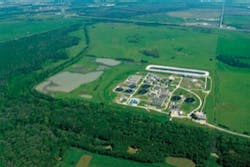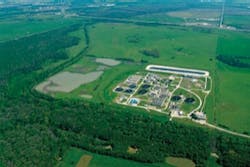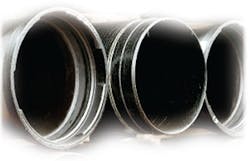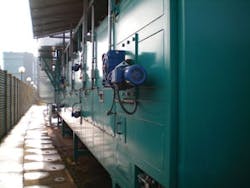Advanced technologies have become the building blocks of a modern wastewater treatment plant (WWTP). New generation controls, treatment systems and disinfection methods can improve virtually every link along the process chain, from the control of peak flow, to disinfection, nutrient removal, effluent quality and even sludge management.
The award-winning plant serving Carmel, Indiana, is a case in point.
Carmel is one of the affluent edge cities on the north side of Indianapolis. The rapid growth in recent years has demanded farsighted planning and investment by the community of approximately 70,000 residents, said Edward Wolfe, operations manager, who has witnessed many changes during his 33-year career in wastewater management. Craig Carter, the plant manager and another 33-year veteran, has 25 personnel working at the facility, including four Class IV and the rest with Class I to III certifications. Jordan Kleinsmith, assistant plant manager, has 25 years experience and is always eager to point out the features of their pacesetting treatment complex.
The 12 mgd facility has earned a string of environmental awards while removing risks and lowering operational costs. It comes as no surprise, therefore, that this progressive facility attracts frequent visit from other public works officials and designers who are interested in the technologies that contribute so much to the environmentally compatible operations.
The plant has a lengthy list of awards, including the US Environmental Protection Agency recognition as Best Managed Municipal Plant in its class. In 2008, the National League of Cities recognized the Carmel WWTP for "best practice" in process operations.
The plant also earned the Indiana Governor's Award for Environmental Excellence last year after replacing chemical disinfection with an ultraviolet (UV) system. Other awards listed on the city's website clearly rank this plant among the nation's best managed facilities.
Advancements in technologies and management practices are light years ahead of the era when wastewater lagoons and harsh chemicals were standard for removing pathogens. In fact, the plant's management considers the application of UV disinfection as the cornerstone of a series of upgrades to the WWTP in recent years. These increased the capacity from 8.8 mgd to 12 mgd and have made the facility a model of environmental compliance.
The upgrades follow a comprehensive Facility Plan developed by Jones & Henry, an Ohio-based engineering firm that has worked with the city since 1992. The first project replaced the existing static screens with two cylindrical fine screens and screenings compaction. Following those initial steps came the addition of two primary settling tanks, return sludge pumps, hydraulic modifications, and new Sanitaire fine bubble diffusers in all aeration tanks, along with Turblex blowers and a DO control system.
That set the stage for perhaps the most important upgrade – a 36.0 mgd, WEDECO ultraviolet disinfection system completed in the summer of 2005. The upgrade followed Indiana Department of Environmental Management's mandate to remove chlorine from treated effluent before release into the White River, the receptor for discharges from Carmel and other municipal WWTPs.
Prior to the UV system, the Carmel utility had resorted to scrubbing chlorine from the effluent using sulfur dioxide during the mandated disinfection season of April 1 to October 31, when the state E. coli limit is set at not more than 235 colony forming units (cfu) per 100 milliliters (ml). The gaseous chemicals were kept on site in four, one-ton cylinders for chlorine and two to three one-ton cylinders of sulfur dioxide. As most other plants have experienced, a minor amount of residual chlorine always remained and the procedure released low levels of sulfuric acid that posed an additional risk to aquatic life.
Both chemicals also presented the additional risk of a handling accident causing a release into the atmosphere.
"Wastewater plant operators at Carmel and elsewhere have confronted added safety concerns with the advent of dechlorination," said Dan Miller, an expert in the field with Jones & Henry. "They have to handle another hazardous chemical which has public safety concerns beyond their immediate plant environments.
"UV typically works under most plant conditions. Larger plants should pilot test and as a minimum, smaller plants should have a collimated beam test completed to measure the anticipated dosage requirements." he added. "Plants with low inflow and infiltration have much less capital investment since they typically experience lower peaks. One factor to consider is the use of iron compounds to remove phosphorous at some plants in which case they may wish to pilot test the technology."
The city was evaluating some options to improve the disinfection system, which required doubling the amount of chlorine and sulfur dioxide stored on site, when the 9/11 terrorist attack presented the grim scenario of terrorists unleashing chlorine gas or sulfur dioxide across heavily populated areas of Carmel, Fishers and Northern Indianapolis.
"That triggered a heightened interest in alternative disinfection methods," Kleinsmith said. "We became confident that changing to UV disinfection at our plant would resolve the twofold concerns of regulatory compliance and risk reductions without compromising our effluent quality.
"Working closely with Jones & Henry Engineers, the department established a group of six evaluators once the decision was made to adopt UV disinfection instead of chemical contact. The group considered three UV system manufacturers, conducting plant and factory tours, before rating each system on a matrix," Kleinsmith said.
The resulting score favored the WEDECO UV system supplied by ITT Water & Wastewater. The system is equipped with an automatic cleaning feature that keeps the quartz sleeves crystal clear and sustains pathogen kill. A building equipped with an overhead crane was built atop an existing chlorine contact tank retrofitted to enclose the UV system that is split in half to create two channels for alternating operation and redundant backup.
The former chlorine tank was retrofitted with a UV disinfection system. The same building atop the old chlorine disinfection tank now houses the two UV channels.
There are a total of 288 low pressure high intensity UV lamps divided into two channels. The lamps are among the most energy-efficient in the market and warranted for 12,000 hours of operation. One channel handles the typical 8 to 13 mgd flow which undergoes added settling before passing through the UV channels at a desirable 3 to 5 mg/l suspended solids. The UV system has the ability to vary the output of the lamps based on measured UV intensity and flow rate. That way it uses the lowest possible amount of electricity while always applying a sufficient UV dose. When the flow reaches 15 mgd for 45 minutes the second channel of lights is activated to receive the split flow. The total system easily handles 35 mgd, Kleinsmith said.
Using the previous chemical disinfection, the plant typically could achieve E. coli readings ranging from 100 to 235 cfu per 100 ml, he said. By comparison, the UV system during the past disinfection season normally achieved single-digit readings and a high of 54 cfu per 100 ml, all well below the state's 235 E. coli maximum.
UV disinfection also offered economic benefits and complies with the city commitment to implement green initiatives in all departments, emphasizes Operations Manager Wolfe. The WEDECO system and infrastructure changes at the time cost approximately $1.6 million. Up until then, chlorine and sulfur dioxide had cost $30,000 per year, plus operational maintenance costs.
Teresa Lewis, administration and laboratory assistant plant manager, a 27 year veteran, recognized a time and cost savings could occur in the lab using UV disinfection instead of chlorine and sulfur dioxide. Their elimination would reduce the amount of lab testing, the final effluent samples would not require testing for residual chlorine and then dechlorinated prior to conducting CBOD tests. UV would also eliminate having dechlorinating agent in the E. coli sample collection bottles. While eliminating the chemical purchase would not quickly offset the UV investment, the planned facility improvements to continue using them were no longer necessary. Furthermore, the elimination of the contingent risks with chemical disinfection – and environmental benefits – outweigh a simple cost-benefit payback analysis, Wolfe added.
The city took an equally big step by converting to Class A from Class B sludge, the latter once hauled 40 miles away for land application. The automated biopasteurization process that produces Carmel's Class A biosolids was the first installation of its kind in the United States and uses an automated pre-digestion pasteurization interfaced with the plant's anaerobic digesters.
The resulting Class A biosolids are a desirable resource for agricultural and soil blenders without increased volumes, maximized the use of existing digester facilities, on-site use of byproduct methane gas and compatibility with the plant's site and operations.
The application was an ACEC Outstanding Award winner and has been added to the "Best Practices" database for the National League of Cities.
The first phase of the system consisted of three, 3300-gallon tanks that function 24/7 in a sequential mode of fill/react/drawdown batches that can reach 56,000 gpd. The solids in the react vessel are heated to 160-deg F. for one hour, with adjustments made for seasonal variables. After advancing through an anaerobic digester and then centrifuges, the pathogen-reduced sludge is typically 14 wet tpd, 3.1 tpd of biosolids at 22 percent solids. The sludge management of the pasteurization system was further enhanced by the Phase II construction of the solar drying facility that was partially underwritten by a state grant. The energy-conserving facility handles approximately 25 percent of the material.
In each of two UV disinfection channels, only the bulbs and sensors are submerged. All other electrical components such as the ballasts are away from the water in the temperature regulated control room. Visible here are the flex metal conduits that deliver power to the UV bulbs from the junction boxes directly above, where they plug in. Each channel contains 144 UV bulbs, totaling 288 bulbs for the entire disinfection system.
Jones & Henry studied several alternatives to further use the methane gas and create a dryer biosolid product. The review included: sludge drying, microturbines, hot water heat derived from other plant buildings, and construction of a "greenhouse" type of solar drying building with supplemental heat. Solar drying was selected based on its simplicity, continual use of the digester gas, eligibility for the $50,000 state energy grant award, and the "green" nature of using solar heat as a drying method.
A nearby sod farm receives the Class A sludge but other businesses can haul the 75 percent dry solids at the plant's solar building .The utility has promoted the availability of the solar-dried Class A material by distributing samples of the solar-dried byproduct at the city's Farmer's Market and encouraging ratepayers to claim larger volumes at the plant. The change to Class A process saves the city approximately $200,000 per year once spent for fuel costs, labor, equipment maintenance and permits compared to the previous Class B sludge operations.
Furthermore, the city could ultimately market the Class A sludge and actually generate a revenue stream from a byproduct that once presented just added disposal expense. WW






